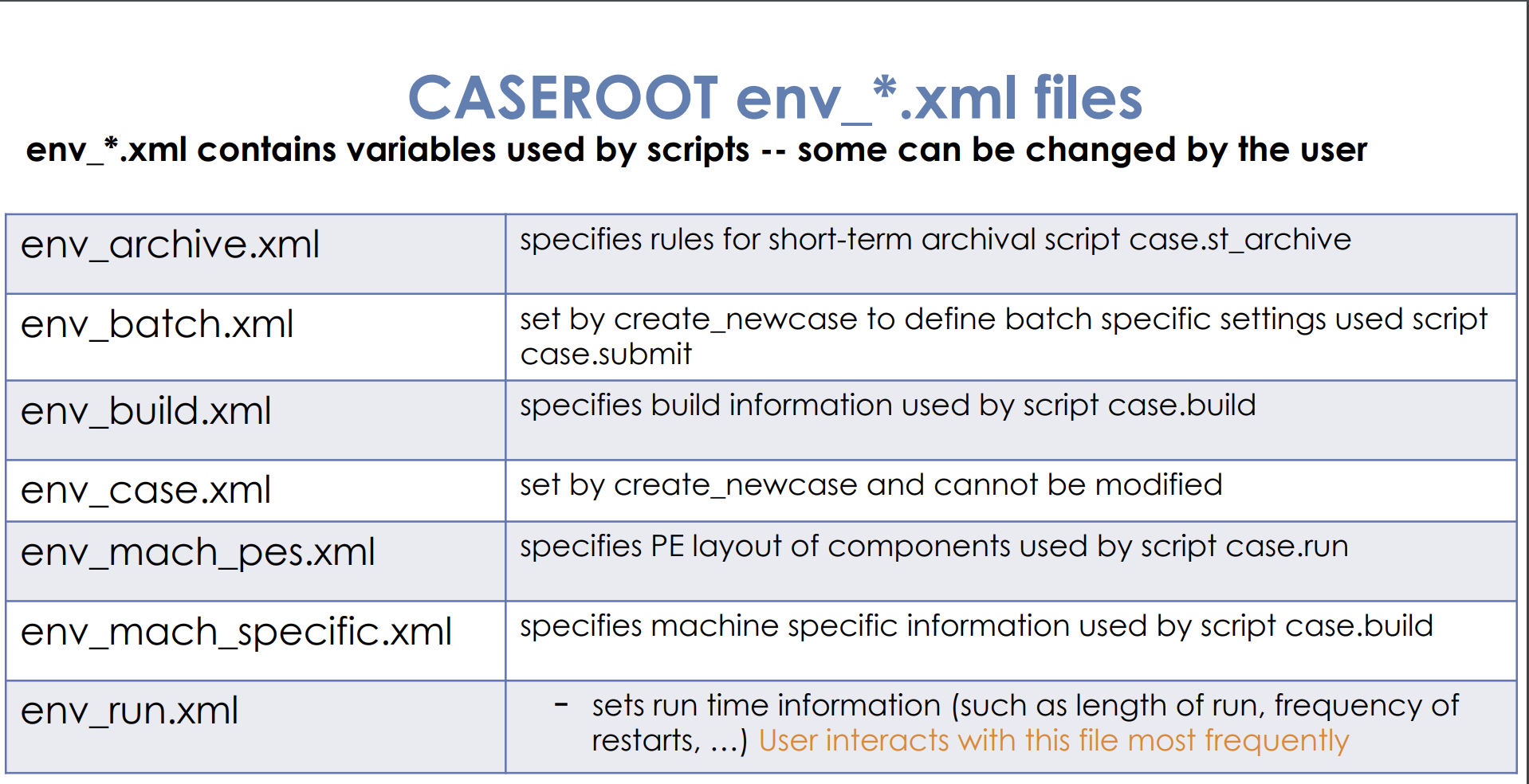Common Runtime Configuration Changes
Overview
Teaching: 0 min
Exercises: 0 minQuestions
What are some common run time configuration changes?
How do I make these changess?
Objectives
The CASEROOT/env_*.xml files control how we compile and run the model. They were creatd with the create_newcase` script.

These files are changed using the xmlchange command, but you can look at them to see what types of change you can make.
Let’s look at env_run.xml in the CASEROOT directory for our new run.
$ cd ~/cases/b.run2
$ more env_run.xml
The file contains ids and their corresponding values as well as a description of the id and sometimes valid_values.
Note that these values can be changed anytime during the model run.
Scroll down (using the spacebar) to find the STOP_OPTION and STOP_N ids.
<entry id="STOP_OPTION" value="ndays">
<type>char</type>
<valid_values>none,never,nsteps,nstep,nseconds,nsecond,nminutes,nminute,nhours,nhour,ndays,nday,nmo
nths,nmonth,nyears,nyear,date,ifdays0,end</valid_values>
<desc>
Sets the run length along with STOP_N and STOP_DATE
</desc>
</entry>
<entry id="STOP_N" value="5">
<type>integer</type>
<desc>
Provides a numerical count for $STOP_OPTION.
</desc>
The default STOP_OPTION is ndays and the default STOP_N is 5 which is why our first run ran for 5 days.
Exit by typing q
Let’s look at the file env_batch.xml
$ more env_batch.xml
Scroll down (using the spacebar) to find the PROJECT id. What is it set to?
Exit by typing q
To find out these values without looking in the files, we use xmlquery
$ ./xmlquery STOP_OPTION,STOP_N,PROJECT
Results in group case.run
PROJECT: UGMU0032
Results in group case.st_archive
PROJECT: UGMU0032
Results in group run_begin_stop_restart
STOP_OPTION: ndays
STOP_N: 5
To change these values, we use xmlchange ID=VALUE
This is great. We don’t have to remember which file they are located in!
Some Common Configuration Changes
STOP_N: Run length time interval
STOP_OPTION: number of intervals to run during the specified wall clock time
RESUBMIT: number of times to resubmit a run
Configure your New Case
Change the STOP_OPTION and STOP_N to Configure your case to run for 48 months. Do not submit your run yet!
Understanding RESUBMIT
This version of CESM2 (f19_g17 resolution) on Cheyenne simulates about 10 model years per wall clock day. Wall clock refers to actual time running on the supercomputer.
You can request a maximum of 12 hours of wall clock time when you submit a run. What this means that that if you want to run a long experiment, you have to run the number of years you can run in 12 hours, then have it resubmit itself where it left off. You can do this by giving it the right combination of STOP_OPTION, STOP_N, and RESUBMIT.What values of
STOP_OPTION,STOP_N, andRESUBMITwould you need to run this version of CESM for 100 years.Solution
STOP_OPTION=nyearsSTOP_N=5RESUBMIT=19
Key Points